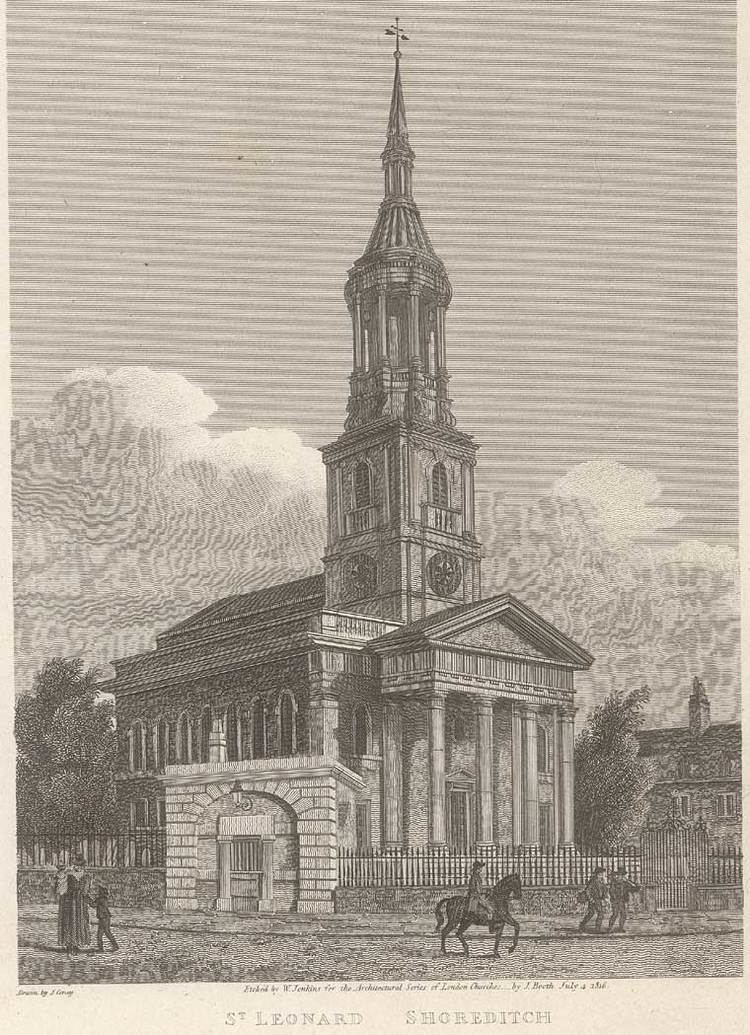Country United Kingdom Style Palladian Vicar(s) Paul Turp | ||
 | ||
Similar St Botolph's Aldgate, Christ Church - Spitalfields, St Dunstan's - Stepney, St John the Baptist - Hoxton, St Botolph‑without‑Bishopsgate | ||
Shakespeare s church st leonard s shoreditch london bbc london news 2008
St Leonard's, Shoreditch, is the ancient parish church of Shoreditch, often known simply as Shoreditch Church. It is located at the intersection of Shoreditch High Street with Hackney Road, within the London Borough of Hackney. The current building dates from about 1740. The church is mentioned in the line "When I grow rich, say the bells of Shoreditch" from the nursery rhyme Oranges and Lemons and is noted as being the resting place of many actors from the Tudor period.
Contents
- Shakespeare s church st leonard s shoreditch london bbc london news 2008
- Origins
- Current building
- Bells
- Tracker Organ
- Church Organ
- Media use
- Distinguished parishioners
- References
Origins
The original church is possibly Saxon in origin, though the first historical reference to it occurs in the 12th century.
The church was situated near The Theatre, England's first purpose-built playhouse, built in Shoreditch in 1576, and the nearly contemporary Curtain Theatre (built in 1577). Several members of the theatrical profession from the Elizabethan period are buried in the church, including:
These, with others of their profession from the period, are commemorated by a large classical memorial erected by the London Shakespeare League in 1913, inside the church, which serves as a reminder of Shoreditch's Shakespearian heritage.
In 1774, the Shoreditch Vestry levied a special poor rate for the purpose of setting up a workhouse for the parish of St Leonard's which highlights the level of poverty in the area.
Current building
Following a partial collapse of the tower in 1716, the medieval church was rebuilt in Palladian style built by George Dance the Elder during 1736–40, with a soaring steeple 192 feet tall – an imitation of Christopher Wren's magnificent steeple on St Mary-le-Bow in Cheapside, – and a giant four columned, pedimented Tuscan portico. Inside the church the entablature is supported by giant Doric columns. Dance was also architect of the Mansion House. Many original 18th-century fixtures and fittings remain, including the font, the pulpit, the communion table, clock, organ case, bread cupboards and commandment boards. It was lit with gaslight in 1817, the first in London.
The parish stocks and whipping post stand in the porch of the church and in the churchyard is the Shoreditch parish pump.
Bells
Whilst the church has had bells for many centuries, as evidenced by its inclusion in the Oranges and Lemons nursery rhyme, the current ring of 12 bells (plus a "sharp second" to allow a lighter ring of eight bells using 1, sharp second and 3–8 to ring a true octave), hung for change ringing, dates from 1994 when the bells were cast by John Taylor & Co, bellfounders of Loughborough.
The bells in the coat of arms of the London Borough of Hackney represent the bells of this church.
Tracker Organ
The organ was built by Richard Bridge in 1756. It is one of the few surviving examples of a tracker organ without pedals. It retains all the original wooden pipes.
The organ is currently in need of restoration.
Church Organ
The church is equipped with a modern electric organ that is used regularly for church services, worship, concerts, and recording. It was the organ used in the Serafina Steer album The Moths Are Real, produced by Jarvis Cocker.
Media use
2010 saw the church being used in the BBC TV comedy series Rev., as a fictional church named St. Saviour's.
Distinguished parishioners
James Parkinson (1755–1824), after whom Parkinson's disease is named, and who lived at Hoxton Square nearby, is commemorated with a stone tablet inside the church; his grave is in the churchyard.
William Lewin, an Elizabethan churchman, tutor, and member of parliament, was buried in the church in 1598.
John George Appold, FRS (1800–65), a pioneer of the centrifugal pump, is commemorated with a stone tablet inside the church.
The Rev. Samuel Annesley (1620–96), the prominent non conformist minister and father of Susanna Wesley (thus grandfather of John & Charles Wesley), is buried in an unmarked plot in the churchyard.
Thomas Fairchild (1667–1724), a pioneer gardener and the author of The City Gardener, endowed an annual sermon at the church on either The Wonderful World of God in the Creation or On the Certainty of the Resurrection of the Dead proved by Certain Change of the Animal and Vegetable Parts of the Creation. These Whitsun sermons become locally known as "The Vegetable Sermon" and continued into the 1990s.
Thomas Legh (lawyer) is also buried here.
